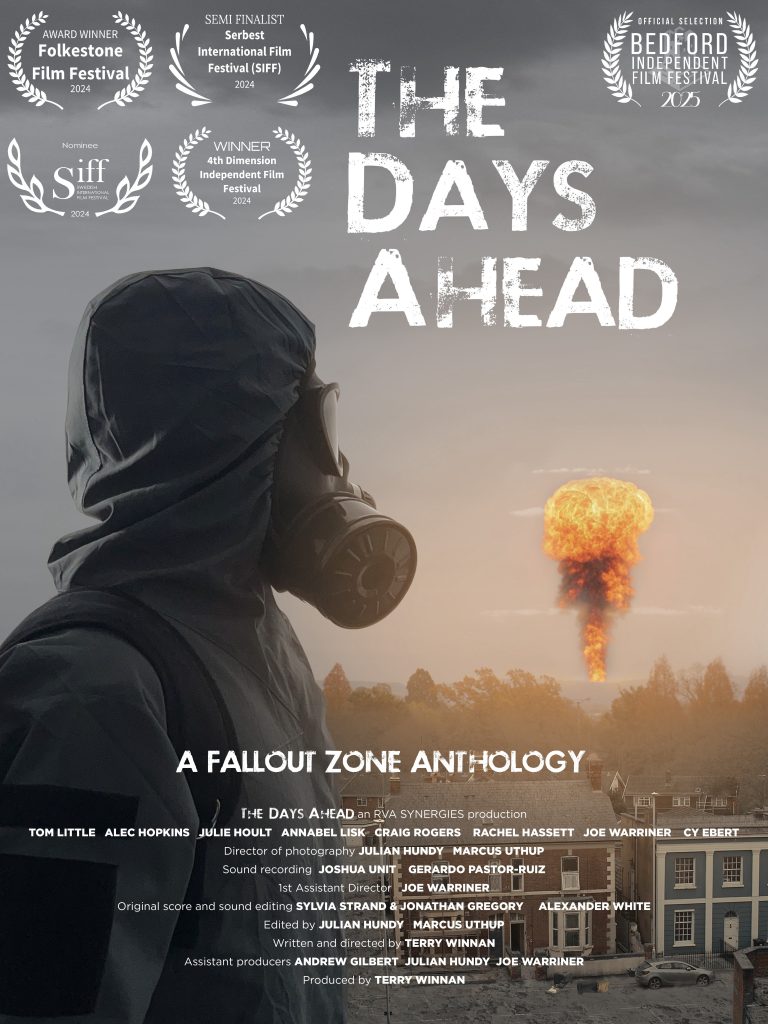Terry Winnan introduces us to a post-apocalyptic Britain in his new feature film The Days Ahead. This haunting anthology offers a chilling vision of nuclear devastation, told not through spectacle but through the fragile humanity of those left behind.

At a time when global instability feels increasingly palpable, The Days Ahead asks a simple but terrifying question: what happens when ordinary people are suddenly forced to confront the unthinkable? Structured as three interlinked stories—Stranded, Prepared, and Post—the film captures the confusion, fear, and fleeting hope of civilians grappling with the fallout of a nuclear strike on the United Kingdom.
The opening chapter, Stranded, traps a group of co-workers inside their office building as the outside world collapses. With no clear information and only the vaguest ideas of how to protect themselves from radiation, their discussions quickly devolve into mistrust and panic. Winnan excels here at creating claustrophobia: the office storeroom becomes both sanctuary and prison, and the arguments over whether to stay put or venture outside carry as much intensity as any action sequence. It’s an unnerving portrait of how fast civility can break down when survival instincts take over.
In Prepared, the focus shifts to a suburban family who appear better equipped for disaster. Chris (Craig Rogers) has stocked supplies, fitted gas masks, and thought through every contingency—but the chapter makes clear that even meticulous planning offers little comfort in the face of such chaos. The family barricade themselves inside their home, trying to ration food, manage health concerns, and fend off the possibility of desperate strangers at the door. The dread here is suffocating; even mundane ailments feel like potential death sentences in a world without help. The performances, particularly from Rogers and Rachel Hassett as his wife, bring a convincing mix of fear, exhaustion, and determination.

The final story, Post, pares everything back. Cy Ebert plays Paul, a man sheltering in an old bunker, whose only connection to life beyond the steel walls comes through faint radio transmissions. It is the quietest and most poignant of the three chapters, lingering on isolation and despair rather than physical threat. As Paul communicates with another survivor trying to protect his family, the film poses existential questions: what does survival mean if it is survival alone? Can we rebuild humanity once it has been shattered? The ending refuses sentimentality, delivering instead a bleak but honest meditation on loss and the faintest glimmer of hope.
What binds these chapters together is Winnan’s insistence on realism. There are no panoramic shots of mushroom clouds or CGI-laden destruction; the bombs are glimpsed only in flashes, their devastation inferred through dialogue, atmosphere, and human behavior. This restraint makes the film all the more unsettling. The terror comes not from spectacle but from the unsettling plausibility of it all—the office arguments, the DIY fallout shelter, the solitary radio in the darkness. These feel like scenarios we might genuinely face, and that ordinariness is what makes them frightening.

Performances throughout are strong, with Ebert, Rogers, and Clara Winnan (as Chris’s daughter) anchoring the film with natural, understated turns. There are moments where reactions feel muted, particularly in Prepared, but the general commitment to subtlety keeps the tone grounded. This is not melodrama, nor disaster-movie heroism—it is messy, human, and authentic.
Technically, the film makes shrewd use of its modest budget. Tightly framed interiors, naturalistic lighting, and careful sound design build tension without overstretching resources. While a few scenes could benefit from more robust audio cues to heighten their impact, the minimalist approach suits the subject matter. Rather than distracting with scale, the film leans into mood and character, making despair its most powerful special effect.
Beyond the specifics of its storytelling, The Days Ahead resonates because of its themes. It is as much about human relationships as it is about nuclear catastrophe: how people cope, fracture, and cling to one another when everything else has vanished. It interrogates the illusion of preparedness, the fragility of social order, and the loneliness of survival. Perhaps most haunting is the way it highlights how quickly the everyday can turn alien—an office, a family living room, a bunker—all spaces we recognize, transformed into theatres of dread.
At just 75 minutes, the film is taut, focused, and unrelenting. It is heavy with arguments, breakdowns, and moments of despair, but rewards endurance with a sense of stark honesty. Winnan refuses to sugarcoat the apocalypse, and the result is a work that feels disturbingly credible. It is a story not of action heroes or miraculous rescues, but of ordinary people facing extraordinary horror, stumbling through fear, and occasionally finding grace in fleeting connections.
The Days Ahead may lack the polish of big-budget disaster films, but it more than compensates with atmosphere, commitment, and emotional weight. It is bleak, unvarnished, and deeply unsettling—and for that reason, it stands out as one of the most compelling independent dramas of recent years.
A grim but gripping vision of nuclear catastrophe, The Days Ahead delivers its terror not with spectacle but with authenticity. A sobering, tightly drawn indie drama that lingers long after the credits.
Leave a Reply